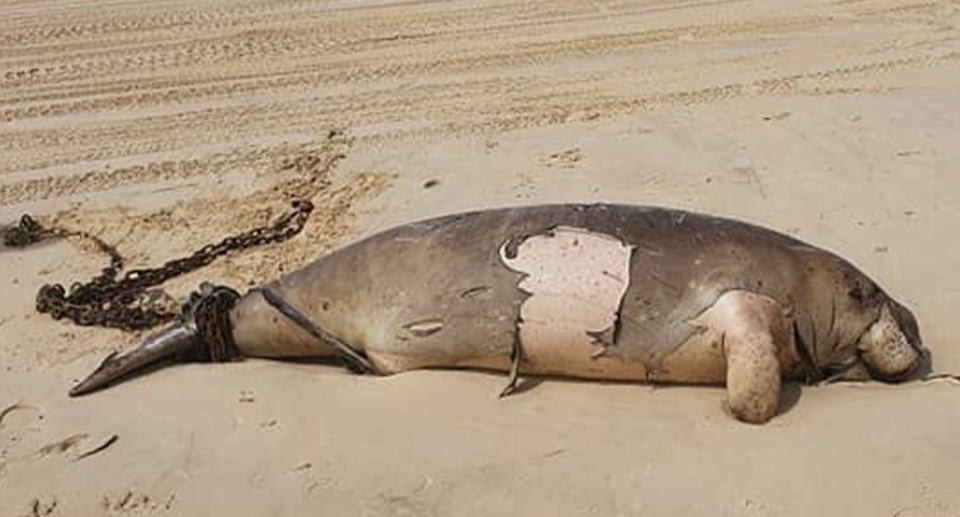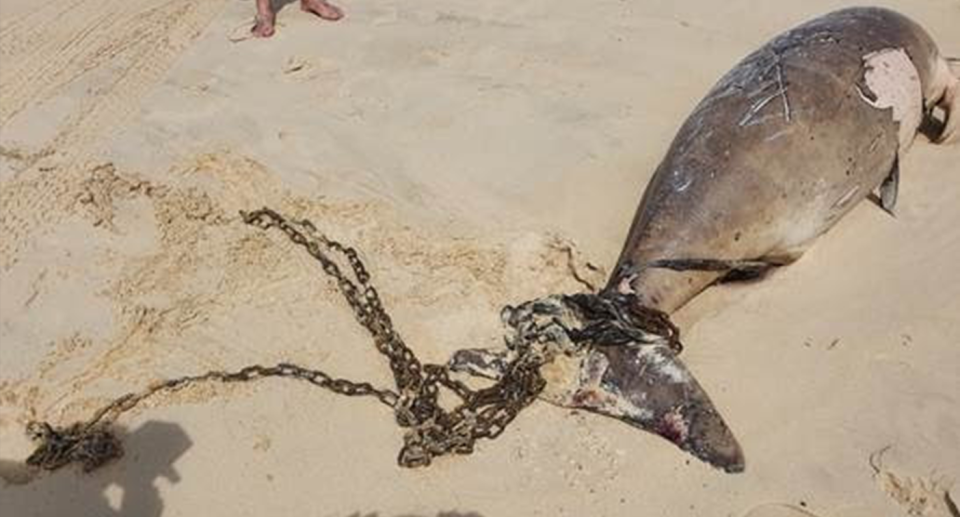Horror find on Queensland beach leads to call for government rethink
Images of a dead marine mammal killed by a shark net are just one more reason to ban a government ‘safety’ program according to animal welfare advocates.
Heartbreaking photos show a dugong’s body lying on the sand at beach at Inskip Point, 180km north of Brisbane.
The animal’s skin can be seen peeling and the thick chain appears to have been wrapped around its tail in images sent anonymously to Australian Marine Conservation Society (AMCS) on Sunday.
The Queensland department of fisheries confirmed the dugong drowned off Rainbow Beach after becoming entangled in shark control program equipment.

They reported the animal washed ashore due to strong currents after a disposal attempt on September 14, said to be in line with government regulations.
“Public safety is a priority of the Shark Control Program and due care is taken to avoid deceased animals washing up on beaches,” a department spokesperson said.
“Deceased animals may pose a public health risk or attract sharks to beaches, which is why they are weighed down and disposed of out to sea.”
While the Queensland government says it makes every effort to minimise incidents involving non-target species, the AMCS and Humane Society International say the bycatch is too high, noting the program has been responsible for entangling and drowning 274 dolphins, 106 turtles and 693 rays since 2001.

AMCS shark scientist Dr Leonardo Guida told Yahoo News Australia that when our “iconic wildlife” is caught in the nets, they often die a slow, “distressing” death.
Sharks, in particular, he says suffer when caught in the nets, noting they can take up to an hour to drown.
Staggering bushfire report reveals government's 'horrifying' effort to save wildlife
'Like velcro': Careless act leaves starving bird unable to eat for DAYS
'Give them a good death': Debate rages over live lobster cooking
“If you’re a shark and you need to move to breathe, and you can't breathe properly, that entire period of time is unfathomably stressful,” Dr Guida said.
“I can't describe it other than it would be absolutely horrible.”
Call to rethink shark protection with modern design
Dr Guida says it is rare for the public to “bear witness” to the the victims of the nets, and that the images of the dead dugong clearly highlight why shark nets must be removed immediately.
He argues that the nets do not work as impenetrable barrier to the beach as many swimmers believe and do not stop sharks from reaching the shore.
The basic equipment, he says, has not changed since its introduction 60 years ago, and it is time for a rethink of beach safety.

“They’re a fishing net set with the intention to catch and kill,” he said.
“Shark nets are only 180 metres long, and sharks can swim over, under and around them.
“The only thing they guarantee is the death of our iconic animals.
“In other no other aspect of our daily lives, would we expect safety standards from 60 years ago, so why is beach safety any different?
“We really need to move with the times modernise the shark control.”
Do you have a story tip? Email: newsroomau@yahoonews.com.
You can also follow us on Facebook, Instagram and Twitter and download the Yahoo News app from the App Store or Google Play.




